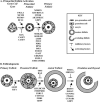Genomic markers of ovarian reserve
- PMID: 24101221
- PMCID: PMC4043392
- DOI: 10.1055/s-0033-1356476
Genomic markers of ovarian reserve
Abstract
Ovarian reserve and its utilization, over a reproductive life span, are determined by genetic, epigenetic, and environmental factors. The establishment of the primordial follicle pool and the rate of primordial follicle activation have been under intense study to determine genetic factors that affect reproductive lifespan. Much has been learned from transgenic animal models about the developmental origins of the primordial follicle pool and mechanisms that lead to primordial follicle activation, folliculogenesis, and the maturation of a single oocyte with each menstrual cycle. Recent genome-wide association studies on the age of human menopause have identified approximately 20 loci, and shown the importance of factors involved in double-strand break repair and immunology. Studies to date from animal models and humans show that many genes determine ovarian aging, and that there is no single dominant allele yet responsible for depletion of the ovarian reserve. Personalized genomic approaches will need to take into account the high degree of genetic heterogeneity, family pedigree, and functional data of the genes critical at various stages of ovarian development to predict women's reproductive life span.
Thieme Medical Publishers 333 Seventh Avenue, New York, NY 10001, USA.
Figures

References
-
- Mathews TJ, Hamilton BE. NCHS Data Brief. Vol. 21. Centers for Disease Control and Prevention: U.S. Department of Health and Human Services; 2009. Delayed childbearing: more women are having their first child later in life. - PubMed
-
- Milan A. Report on the Demographic Situation in Canada. Component of Statistics Canada Catalogue no. 91-209-X. Government of Canada; 2013. Fertility: overview, 2009 to 2011.
-
- Broekmans FJ, Soules MR, Fauser BC. Ovarian aging: mechanisms and clinical consequences. Endocr Rev. 2009;30(5):465–493. - PubMed
-
- Jagarlamudi K, Rajkovic A. Oogenesis: transcriptional regulators and mouse models. Mol Cell Endocrinol. 2012;356(1–2):31–39. - PubMed
Publication types
MeSH terms
Substances
Grants and funding
LinkOut - more resources
Full Text Sources
Other Literature Sources
Medical

